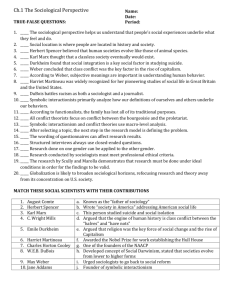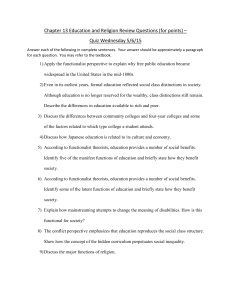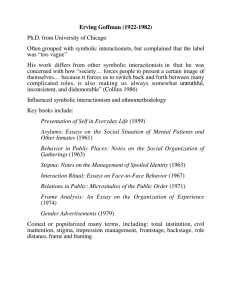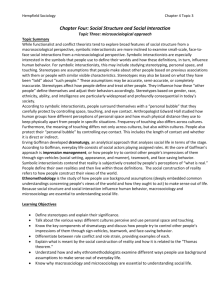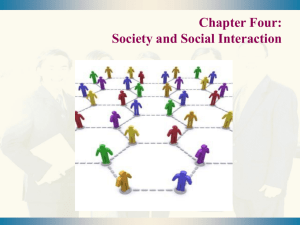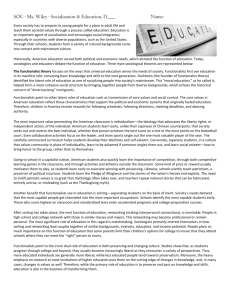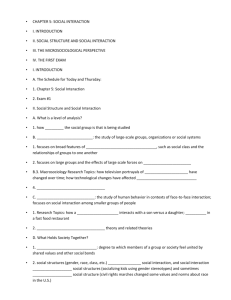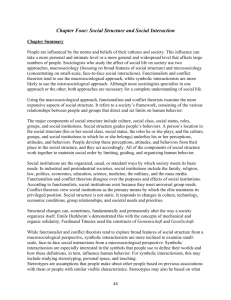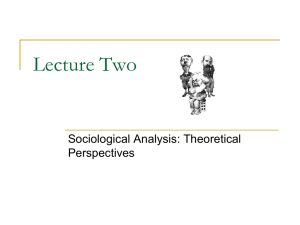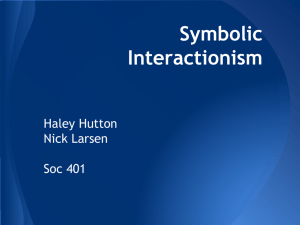Sociology - Social Structure and Interaction UNIT IV
advertisement
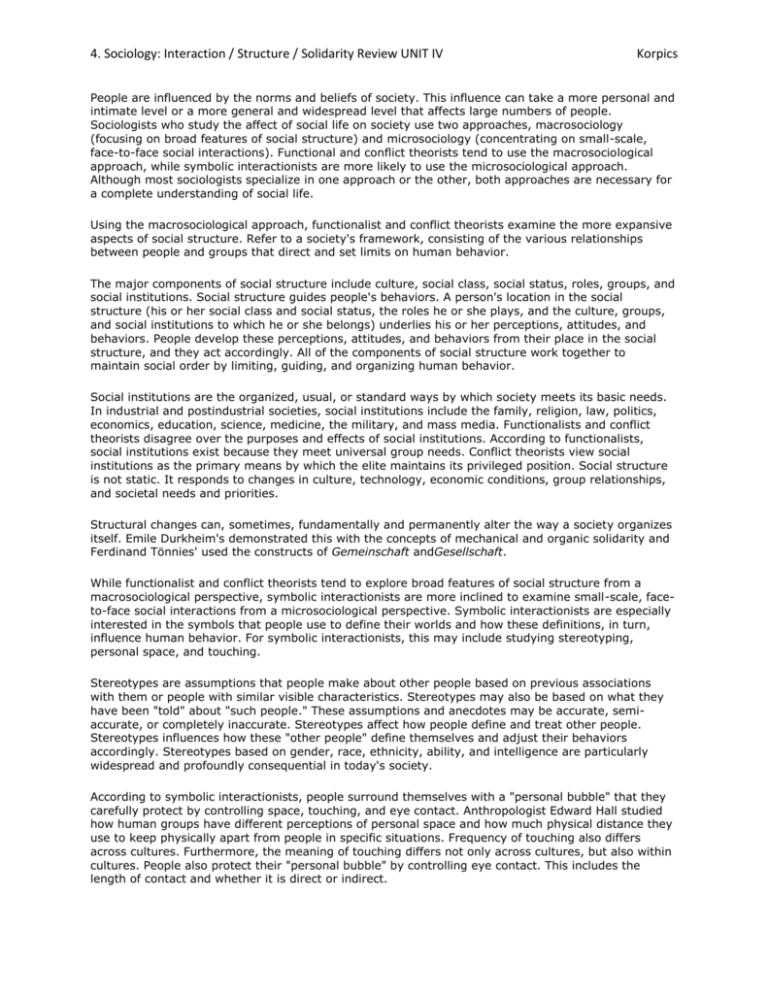
4. Sociology: Interaction / Structure / Solidarity Review UNIT IV Korpics People are influenced by the norms and beliefs of society. This influence can take a more personal and intimate level or a more general and widespread level that affects large numbers of people. Sociologists who study the affect of social life on society use two approaches, macrosociology (focusing on broad features of social structure) and microsociology (concentrating on small-scale, face-to-face social interactions). Functional and conflict theorists tend to use the macrosociological approach, while symbolic interactionists are more likely to use the microsociological approach. Although most sociologists specialize in one approach or the other, both approaches are necessary for a complete understanding of social life. Using the macrosociological approach, functionalist and conflict theorists examine the more expansive aspects of social structure. Refer to a society's framework, consisting of the various relationships between people and groups that direct and set limits on human behavior. The major components of social structure include culture, social class, social status, roles, groups, and social institutions. Social structure guides people's behaviors. A person's location in the social structure (his or her social class and social status, the roles he or she plays, and the culture, groups, and social institutions to which he or she belongs) underlies his or her perceptions, attitudes, and behaviors. People develop these perceptions, attitudes, and behaviors from their place in the social structure, and they act accordingly. All of the components of social structure work together to maintain social order by limiting, guiding, and organizing human behavior. Social institutions are the organized, usual, or standard ways by which society meets its basic needs. In industrial and postindustrial societies, social institutions include the family, religion, law, politics, economics, education, science, medicine, the military, and mass media. Functionalists and conflict theorists disagree over the purposes and effects of social institutions. According to functionalists, social institutions exist because they meet universal group needs. Conflict theorists view social institutions as the primary means by which the elite maintains its privileged position. Social structure is not static. It responds to changes in culture, technology, economic conditions, group relationships, and societal needs and priorities. Structural changes can, sometimes, fundamentally and permanently alter the way a society organizes itself. Emile Durkheim's demonstrated this with the concepts of mechanical and organic solidarity and Ferdinand Tönnies' used the constructs of Gemeinschaft andGesellschaft. While functionalist and conflict theorists tend to explore broad features of social structure from a macrosociological perspective, symbolic interactionists are more inclined to examine small-scale, faceto-face social interactions from a microsociological perspective. Symbolic interactionists are especially interested in the symbols that people use to define their worlds and how these definitions, in turn, influence human behavior. For symbolic interactionists, this may include studying stereotyping, personal space, and touching. Stereotypes are assumptions that people make about other people based on previous associations with them or people with similar visible characteristics. Stereotypes may also be based on what they have been "told" about "such people." These assumptions and anecdotes may be accurate, semiaccurate, or completely inaccurate. Stereotypes affect how people define and treat other people. Stereotypes influences how these "other people" define themselves and adjust their behaviors accordingly. Stereotypes based on gender, race, ethnicity, ability, and intelligence are particularly widespread and profoundly consequential in today's society. According to symbolic interactionists, people surround themselves with a "personal bubble" that they carefully protect by controlling space, touching, and eye contact. Anthropologist Edward Hall studied how human groups have different perceptions of personal space and how much physical distance they use to keep physically apart from people in specific situations. Frequency of touching also differs across cultures. Furthermore, the meaning of touching differs not only across cultures, but also within cultures. People also protect their "personal bubble" by controlling eye contact. This includes the length of contact and whether it is direct or indirect. 4. Sociology: Interaction / Structure / Solidarity Review UNIT IV Korpics Erving Goffman developed dramaturgy, an analytical approach that analyzes social life in terms of the stage. According to Goffman, everyday life consists of social actors playing assigned roles. At the core of Goffman's approach is impression management, how people try to control other people's impressions of them through sign-vehicles (social setting, appearance, and manner), teamwork, and face-saving behavior. Symbolic interactionists contend that reality is subjectively created out of people's perceptions of "what is real." People define their own realities and then live within those definitions. The social construction of reality refers to how people construct their views of the world, while ethnomethodology is the study of how people use background assumptions (deeply embedded common understandings concerning people's view of the world and how they ought to act) to make sense out of life.
